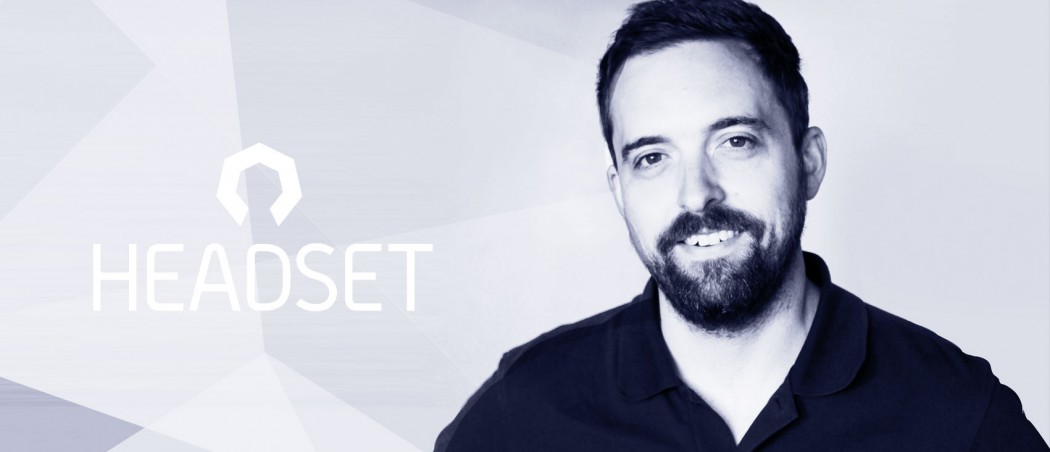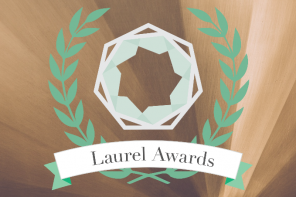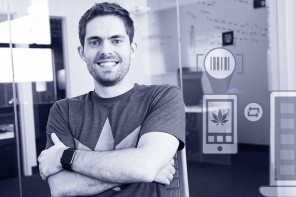Cy Scott And His Leafly Co-Founders Begin New Venture With Headset
Cy Scott, along with his other two Leafly Co-Founders, recently exited Leafly to begin Headset, a tech company that will provide insight and education to the cannabis industry. The biggest difference between the two companies is that Headset will be geared towards the business side of the industry, as opposed to Leafly, which was more consumer focused. But how did Cy decide it was time to move on? Why did he become the CEO and Co-Founder of Headset? What are they working on and how will it impact the market? For the first time at Cashinbis, we interview an entrepreneur on how he went from a startup, to a national company, to a successful exit and new project.
Prefer to listen to this interview? Listen below!
Take us all the way back. What you were doing before Leafly?
Yeah, all the way back. Prior to starting Leafly, I was in the technology space. Actually, all three founders of Leafly, myself, Scott Vickers and Brian Wansolich, were all at the car valuation service Kelley Blue Book (KBB.com). We were still there while we were boot-strapping Leafly together. Technology is where I’ve been for a long time, from startups to large corporate companies. Leafly was a natural extension of that, marrying the technology world with the cannabis world.
Did you three meet at Kelley Blue Book, or did you guys know each other before that?
I’ve known Scott since our college days together, back in 2003ish. We both met Brian at KBB back in 2008. We’ve known each other for a long time and worked together in some capacity for a long time. That dynamic and history together really helped make Leafly so successful. Having a good team is so critical on any new project, so it’s great to have them along for the next one with Headset.
It’s amazing that you guys are able to do this and then still get along. How is that relationship?
It’s a tough road, starting a new company, so it’s nice to have guys you can trust and have been working with for a while. Plus we haven’t killed each other yet!
It’s nice to have three of us, so we get a tie-breaker when we get into heated discussions. It’s really important when you’re doing a startup to have a good team. A co-founder, let along two co-founders, is so critical, especially when you guys have skills that offset each other. It really does help. It’s a tough road, starting a new company, so it’s nice to have guys you can trust and have been working with for a while. Plus we haven’t killed each other yet!
Did you ever imagine that Leafly would grow into what it grew into, or did it surpass what you all thought it would be?
It absolutely surpassed what we thought it would be. I think with any startup, you have high ambitions and big hopes for what it could be, but I think most startups have a tough time succeeding. To see Leafly get to the scale and level that it did and that it continues to be so successful in the industry is just fantastic.
I can mention the mention the Leafly project to almost anyone, particularly in the cannabis space and they’re well aware of it, which is much different than the early days, when you launch a new site and a few months in you’re asking people, “Have you heard about Leafly?” and no one has. It’s really great to see how successful it’s been and what a big impact it’s had on the industry.
All three of you come from a technology background. What do you think made you guys so successful on the technology side of Leafly?
I think Leafly really solved a need, which is critical when you’re founding a company. What problem are you solving? With Leafly, it was a lack of information around strain and location, or dispensary data.
We were located in California when we founded Leafly. At that time, a consumer would go to a dispensary and they’d have 30 or more strains to choose from with all sorts of different effects associated with them. There was no legitimate place to get good, quality information on the variety of strains and how they might affect you, let alone where you should go to get them.
Leafly solved that need. We really wanted to create something that had a more mainstream appeal. We saw cannabis going in that direction, as well as something that medical patients could use and would feel comfortable consuming. I think the way we presented and talked about cannabis really resonated with people. That’s where the success started.
I think the way we presented and talked about cannabis really resonated with people.
Then, after selling to Privateer and really increasing our resources, we were able to scale up and ride the wave of legalization after Washington and Colorado. There was a lot of interest in this space, people were looking for information and Leafly was a natural resource at the time for that, so we got a lot of press there. Right place, right time definitely helped.
We also had some big marketing campaigns. You may remember the New York Times ad we did. That was the first time, to our knowledge, that the New York Times allowed any cannabis company to advertise in their paper. We had a full-page ad and that drove a lot of interest as well. From there, we got more press and that success cycle continued.
You rode the Leafly wave as far as you wanted to take it. How did you know it was time for you to jump off that wave and paddle back out to find the next wave?
It wasn’t an easy decision by any means. The three of us are entrepreneurs and startup guys, so it’s in our DNA to always want to tackle new problems. It’s a common thing you’ll see across the tech world. I’m sure it will start coming to the cannabis world as more people follow this pattern, where you build up a company and get it to a great spot where it’s successful, then maybe you have an acquisition or potentially go public. Then you’re able to move on to tackle a new challenge.
The three of us are entrepreneurs and startup guys, so it’s in our DNA to always want to tackle new problems.
We knew it was time in the sense that we grew Leafly to a great scale. Each month brings more and more customers, users and app downloads. It just continues to be a great service. We had the team up to 35 people by the time we left. We found a great new CEO and were able to transition a lot of responsibilities to the team. At that point we were able to step away and try this new challenge.
Something unique about this process is you weren’t the lone founder. It was all three of you and you all left at the same time. When did the process begin and who brought it up?
We started conversations a few months before we made the jump. We really wanted to wait until we had a good CEO candidate that could take the reins of the company. We hung in there, kept it going and then, once we had the new CEO, it made a lot of sense. Leafly is going to be well taken care of under his watch, and under Privateer‘s watch, so we decided it was the right time. It did take a few months of planning and it’s never easy, especially when it’s something that you founded, like a startup. It’s like your baby, so it’s hard to leave that but we’re excited to see it grow from the outside.
We really wanted to wait until we had a good CEO candidate that could take the reins of the company.
What was your last day like at Leafly? What was the next morning like after you left?
The last day we had a celebration, which was nice. It was really great, very bittersweet. We love the team there and Leafly is a success because of all of their hard work and dedication. While we started the idea and had the initial project, it wasn’t until we had all the individuals contributing across all channels, whether it’s sales, marketing or engineering that Leafly really got it to where it is today. It was really nice for the team to give us a great goodbye.
Then the next day was like, okay, we’ve done it. Now it’s time to start thinking more about what this next project could be and how we’re going to tackle it. We did take a little bit of time before we jumped in, but not too much, just some time to breathe and take a lay of the land. We jumped right into Headset shortly after.
You didn’t have your next project figured out. You guys left and then took some time to marinate on it?
That’s right. We had an idea of the problem that we’re going to be solving. With Headset, that’s really a lack of market intelligence and business intelligence data for retailers, product manufacturers and growers. They’re all having trouble making really good decisions because they don’t have the resources that exist in so many other verticals. We knew that that his was a real need in the industry and we’d heard it from all sorts of partners that we’ve had during our time with Leafly. However, we didn’t know exactly how we were going to tackle it and what the solution was going to look like.
Headset is a service for the industry, so more business to business, supporting retailers and product manufacturers, giving them the tool set that sets them up for success.
While we had the problem that we wanted to tackle, we didn’t really have the solution planned out. We’re still pulling it together and building. It’s still early on in the life cycle of the project. We knew the problem right out of the gate and now we’re really pulling together the solution.
You mentioned the problem and that you had the need and the ability to solve it, but you could have taken this and applied it to anything in the industry. Why did you choose this method specifically?
I think it’s one of the common threads across the industry is this lack of real-time data. Aside from banking, it is probably the biggest issue that people have in building a successful cannabis company. It’s the trajectory that we feel the industry is on as it becomes more accessible, more mainstream. More and more players and brands are going to be entering the space, and these brands are going to need these resources, so it made a lot of sense to tackle this.
This type of service is something that exists in other verticals, in any sort of retail, whether it’s grocery or television. There are companies out there that measure these things and provide the data back to companies that are involved. We’re taking that model and applying it to cannabis because we know the trajectory is there. With more legalization on the ballot and potentially passing, we think the industry is going to look a lot like other industries, so we’re just trying to help it get there faster.
For people who might be a little bit more technologically impared, can you break down the difference between what Leafly did and what Headset is going to do for the cannabis industry?
Leafly was very consumer focused. At Leafly, we were all about educating and empowering the cannabis consumer, whether it was an experienced cannabis consumer or someone who’s looking at cannabis for the first time. It was very end-user centric.
Hang in there new entrepreneurs! Keep working at it. If it doesn’t hit right away it doesn’t mean you’re wrong.
Headset is a service for the industry, so more business to business, supporting retailers and product manufacturers, giving them the tool set that sets them up for success. We want these companies to be successful because, if they’re successful, it will help the industry as a whole succeed. That’s our vision. We want cannabis to be accepted and accessible nationwide and we want to help it get there faster. Headset’s going to play a big part in that.
On the technology side, what do you think you learned in the development of Leafly that’s going to help you get there faster with Headset?
Experience. The more you’ve done startups, the more you learn the pitfalls. You won’t make the same mistakes twice. We learned a lot through the development of Leafly and we’ll probably apply a lot of that knowledge, whether it’s engineering, marketing, how to market a product properly for this space, or even sales. We learned a great deal at Leafly and we will definitely be applying it to this new venture.
Most of the people who look at Leafly now see it as this big Goliath, but it wasn’t always that. You guys did have to go through your trials and tribulations to get to where you ended up. Can you share any of those instances with us?
Something that seems so obvious now, but it really wasn’t at the time, is there’s no such thing as overnight success. You’ve probably heard that quite a bit but it’s really true. Leafly took a long time to get it to where it is. Five years is a lifetime in this industry. When we started it was strictly medical. There were no recreational markets. Polling was positive, but it wasn’t anywhere near the levels we see today. It takes time and effort to really gain the traction you are looking for.
Hang in there new entrepreneurs! Keep working at it. If it doesn’t hit right away it doesn’t mean you’re wrong. Just keep trying new things and hopefully you’ll get there like we did.
What was your favorite perk of working at Leafly? Was it the extracurricular partying or just talking to people in the industry?
The Leafly office is just like any other technology office, not that exciting, unfortunately. However, it’s a good environment to get a lot of good work done. That definitely wasn’t the best part.
I think the part we enjoyed the most was the access to the industry that it enabled us to have. We could go visit some of the biggest growers or work with some of the biggest brands and see a lot of behind-the-scenes stuff. Just opening the doors up to the industry was really cool. Because the name Leafly carried so much weight and still does, it gave us a unique perspective and viewpoint of the space. It’s great to have that, especially in this developing world.
Can we talk about the names for a minute? Leafly is relatively associable with cannabis. It would give off that image. Headset doesn’t. Was that strategic, that you wanted to have something that seemed autonomous from the cannabis industry?
Yeah, a little bit. With Leafly, the logo plays to the cannabis industry, but it’s not blatantly obvious that it’s cannabis. We did the same thing with Headset, but it’s a little more obscured. We just liked the word. It sounds interesting. It’s not obviously cannabis but it does have a little bit of roots in what we’re up to. Head stash, head space. The head term is very much associated with cannabis.
If you’re thinking about doing a startup, take some time. Do your research. Maybe go work for a startup.
Then the ‘set’ comes from the multitude of data sets that we’re working with as we pull all this together for the intelligence platform, competitive ‘set’ analysis. We thought Headset had a nice ring to it.
This next question we have yet to cover on Cashinbis. In your mind, what do you think someone should look out for when they think, “I’m going to leave this company”? When is a good time? How do you go about making that decision overall?
It’s definitely not an easy decision. You want to weigh where the company is at before you make the move. You never want to burn bridges or leave a group in a lurch. If you’re very critical to operations at your existing company, you wouldn’t necessarily want to leave but sometimes opportunities come up so you have to weigh everything as pros and cons in a moment. Before you leave, especially if you’re pursuing a new endeavor on your own, make sure that the problem you’re solving is a real problem. Go out and talk to potential customers that you anticipate would one day want to buy your service. Start to validate that product market fit based on an idea before you make the plunge.
So often people have a good idea but they don’t validate it. They’ll jump out there and spend a lot of time, energy and money building it out just to find out that the market place doesn’t have a need for it or it’s hard to get traction. As much as you can validate before you leave, that’s beneficial for sure. Then again, sometimes you just have to take the risk and make the jump. It’s always scary but it could be worth it.
What was the worst business idea that you guys came up with that just absolutely wasn’t going to make it? You had to have some bad ones, right?
Boy, that’s a good question. There are startups I’ve been apart of in the past, not cannabis related, that kind of fizzled out. In the cannabis space, we’ve had ideas here and there, but we’ve never really pursued them.
With Headset, free time is gone. It’s seven days a week. We’re in full-on startup mode.
One idea centered on finding the cheapest price for cannabis in a simple app. We never really pursued and it’s kind of become the running joke. Basically, there was this app years ago, Urban Spoon. I think they’re still around. You’d shake the phone and it would tell you where to go eat. We were thinking about something like that for cannabis and the cheapest price. Someone out there needs to go build that because we always joke about it. I don’t know if there’s any money or traction in it though.
Can you just imagine a couple years from now if that takes off, we’re going to be interviewing them and they’ll be like, “Well, I heard Cy Scott talk about it years ago and now…”
Yeah and I said it was a terrible idea. Now they’re wealthy beyond belief. I hope that happens for someone.
Is there anything you wish you would have known before you started Leafly that you’re glad you know going into this venture?
So much and a lot of it you can only get through the experience. If you’re thinking about doing a startup, take some time. Do your research. Maybe go work for a startup. A mid-level startup’s a good place to go. If you go to work for a startup that’s very young there’s a lot of risk, but at the same time you usually get more equity in that company, so the rewards are higher. Just depends on your risk tolerance.
Find a company that’s doing something similar or has some parallels and get that experience. Coming from startups and then working in the corporate world at places like Kelley Blue Book really did help me understand how larger organizations work. That’s hard to know when you’re just a scrappy little team pulling together a new app. You don’t really see the transition and startups do go through a transition from very early stage, where Headset’s at right now, to mid-stage where Leafly’s at, and into later stage where you have potentially hundreds or thousands of employees, to be able to really understand all the pieces of that and what that means.
We want to give businesses more insight so they can better understand demand or the competitive landscape before they take the plunge
There’s a lot of great literature out there, a lot of good blogs where you can get some sort of idea of how that looks but unless you’re really in that world you don’t really understand. Go get that experience, put in your time and it’ll help you be more successful in the long run.
Can you tell us a little bit about Cy Scott as a person? What do you do in your free time when you’re not developing companies and starting startups?
No free time any more. With Headset, free time is gone. It’s seven days a week. We’re in full-on startup mode. Here and there I do have a little time to spend with my kids. I’ve got two young daughters, so that’s basically where all my extracurricular activities go at this point. Being a good dad, balancing that responsibility while building a company is really important to me.
Are they old enough to have put makeup on your face yet?
They’re old enough but they haven’t tried that yet, so that’s good. I’ll have to watch out for that.
Can you share with us the actual application of Headset?
Basically, we’re doing a market and business intelligence platform that gives businesses the insights that they need to be successful. Some good examples would be a product manufacturer in Washington who’s looking at possibly pursuing a new segment opportunity and trying to determine if they should make a cookie or a chocolate. Right now, these guys are forced to make a best guess, pick a route and go with it. Then they see how it plays out. We want to give businesses more insight so they can better understand demand or the competitive landscape before they take the plunge. It’s really going to be a platform for them to be developing new products on by utilizing the data that we have.
Right out of the gate we’re tackling Washington and Colorado recreational markets.
With retailers, we’re going to provide insights and operational support to maximizing their opportunities at the store, making sure they have the right assortment of products at the right price while running the right promotions is really important. Bringing a lot of that world that exists in other verticals to the cannabis space is the Headset goal.
Is Headset going to launch nationally or is it going to start in a certain region and look to grow outwards? What’s the plan on that side?
Right out of the gate we’re tackling Washington and Colorado recreational markets. We really want to have a lasered-in, zeroed-in focus on the retail market to start out, but we’re going to be rapidly expanding to other regions.
What’s on the horizon for Headset? What should we look for in the next six months to a year?
We’re building away so stay tuned and check out Headset.io. You can sign up to be notified when updates happen or when we’re releasing stuff to the public. We’re hoping to have something pretty soon. A little too early to make any big announcements but definitely sign up to stay up to date. It’s going to be exciting.
What do you think about Cy Scott leaving Leafly? What do you think about his new venture with Headset? Join the conversation and comment below!










